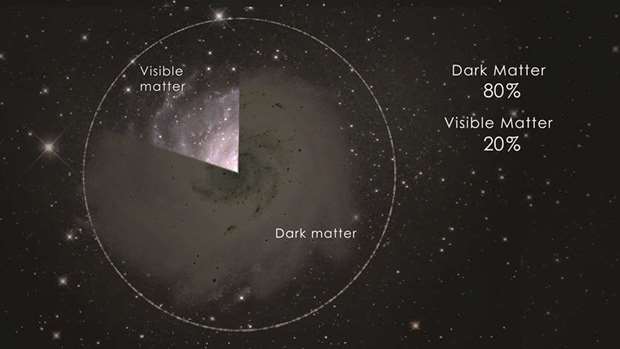The absence of this mysterious stuff in NGC 1052-DF2, described in the journal Nature, could shed light on galaxy formation and help scientists narrow down what dark matter actually is.
“Paradoxically, not seeing the dark matter in this object is evidence that it exists,” said lead author Pieter van Dokkum, an astronomer at Yale University.
Dark matter can’t be seen or touched, but it outweighs all the normal matter in the universe by more than 5 to 1. Astronomers know it’s there because of its gravitational influence, but they can’t detect it any other way.
Until now, every known galaxy has been thought to be filled with dark matter, which forms a halo around its galactic host. Scientists think that clumps of dark matter were the gravitational seeds that actually allowed galaxies to form.
Dark matter also connects giant clusters of galaxies with thin tendrils, forming an enormous cosmic web that gives the universe its structure.
Galaxies about the size of our Milky Way are thought to have around 30 times more dark matter than normal matter (that is, all the stuff that we can see, from stars and supernovas to planets and moons). For both smaller and larger galaxies, that share of dark matter rises even higher.
Take NGC 1052-DF2, which covers about the same volume as the Milky Way but has about 200 times fewer stars and is thus much dimmer and less massive than our galactic home. Such large, dim, sparsely populated galaxies, called ultra-diffuse galaxies, are supposed to have around 300 times as much dark matter as they have normal matter, astronomers say.
Van Dokkum and his colleagues were not looking for a dark-matter-deficient oddball when they started studying NGC 1052-DF2. In fact, a similar galaxy had been found that seemed to be made entirely of dark matter — and he’d been hoping to find another one.
Astronomers figure out how much dark matter is in a galaxy by measuring the velocities at which objects inside it are travelling. The more mass there is, the faster that stars and star clusters go. But because there’s so much dark matter in a galaxy, those stars will travel faster than can be explained by the normal matter we see. The faster they’re moving, the more dark matter there must be.
The astronomers measured the speeds of 10 bright globular clusters within the galaxy to calculate how much dark matter there was. What they found shocked them: The clusters were hardly moving at all.
The ultra-diffuse galaxy at left is rich in globular clusters, which hold the key to understanding this mysterious object’s origin and mass. On the right is a closer look at one of the globular clusters within the galaxy, all of which are much brighter than is typical.
That meant there was very little, if any, dark matter in this galaxy. At most, there was about two-thirds as much dark matter in this galaxy as normal matter. There could potentially be none. Either way, that’s at least 400 times less dark matter than would be expected.
It’s unclear how this ultra-diffuse galaxy developed without dark matter. Perhaps, it formed from the gas flung out as two other galaxies merged. Perhaps, it formed from the gases swept up by quasar winds. Or perhaps its growth was influenced by a massive galaxy nearby.
None of these ideas is a perfect fit for the evidence, van Dokkum said. In any case, the findings show that galaxies do not necessarily require dark matter. And ironically, the fact that the dark matter is missing actually helps establish that it exists. That’s because some scientists have been arguing in recent years that dark matter is not really there — that it’s simply a change in the laws of gravity that we don’t understand.
But if that were the case, this effect would have to be everywhere, all the time. The fact that there appears to be almost no dark matter in NGC 1052-DF2 shows that the two don’t always go hand in hand — and that dark matter must be stuff, not just a tweak in the rules of nature.
“It does show fundamentally that galaxies and dark matter are separable — that a galaxy does not always have dark matter,” van Dokkum said. “It may mean there are places in the early universe where you had a lot of gas but not a lot of dark matter, and that’s something we hadn’t expected.”
Still, van Dokkum pointed out, his study was based only on the movements of the 10 globular clusters in this galaxy because those were all that were available. The next step is to find other galaxies, make the same measurements and see what turns up.
His team already has a few candidates in mind.
“The hunt is now on to see whether we can find any more, and I’m sure other people will try to find those, too,” he said. “Although they’ll probably first try to show that we’re wrong. But after that, they might try to find more.” — Los Angeles Times/TNS



